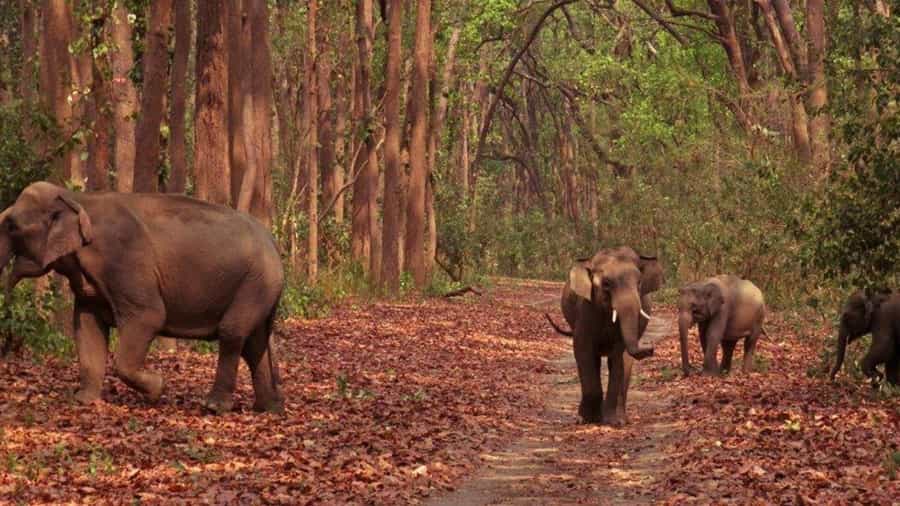Last Updated on 03/01/2025
Enjoy the thrill of visiting Jim Corbett National Park, one of the most famed wildlife sanctuaries in India. Jim Corbett National Park is famous worldwide for the many endangered species of animals it preserves. A jungle safari in the park would be a truly memorable experience for any visitor. Read on to learn more about Jim Corbett National Park.
Everyone loves traveling. Visiting places of adventure is not just traveling but a little more for those with wanderlust. India, with its rich heritage and diversity, has never disappointed travelers, and thus it remains a tourist hub almost all around the year. Wildlife lovers never forget to allot time in their schedule for Corbett National Park, which is one of the oldest national parks and the first tiger reserve in India. Established in 1936, it is situated in Ramnagar, which falls under two districts: Nainital and Pauri in Uttarakhand.
In the foothills of the Himalayas lies the wildlife area of Corbett National Park. Corbett National Park has been famous as the home of the endangered Bengal Tiger. It was earlier named Hailey National Park, but after the influence of Jim Corbett in the establishment of the park, his name was given to it. The wildlife and the scenic beauty capture thousands of tourists every year. It extends through a large area of 521 sq. km, along with the Sonanadi Wildlife Sanctuary, which comprises the entire Corbett National Park area of 1,288 sq. km. Corbett is the destination of several animals, with a wide variety of flora, fauna, and birds. The park has taken complete responsibility for preserving the gifts of nature.

Through the Pages of History
Several areas of the park were under Tehri Garhwal. A Terai tribe named Boksas resided in the area and started their own cultivation. But after the control of the British Raj, the tribes were driven away from the land. The British officer, Major Ramsay, took efforts to protect the forest area. During the 1900s, the land was suggested to establish a reserve park by several British officers like E.A. Smythies and E.R. Stevans.
It came into being in 1936 under the governor, Sir Malcolm Hailey, from which its first name came. Later, in 1954, it was renamed as Ramganga National Park but was finally changed again in 1966 to its current name after the author and wildlife conservationist, Jim Corbett. In 1973, Jim Corbett National Park was selected as the venue for a project named Project Tiger. It is one of the biggest projects launched by wildlife preservationists and naturalists from different parts of the world.
To Begin the Journey
The nearest railway station to Corbett National Park is Ramnagar station, which is 12 km away from the park. Trains like Ranikhet Express and Kumaon Express halt at Ramnagar, but one can easily opt for a more memorable journey via road. State government buses are available from Delhi, Haldwani, and Moradabad to Ramnagar. The park has been divided into five tourism zones: Bijrani, whose gate is at Amadanda; Dhikala, with the gate at Dhangari; Jhirna, whose gate is at Khara, Kalagarh; Domunda, with the gate at Durgadevi; and Sonanadi, with its gate at Vatanvasa.
Travel in the Park
The entry fees for a day visit in different zones are Rs. 100 for Indians and Rs. 450 for foreigners. The vehicle fee ranges from Rs. 250 to Rs.1,500, depending on the weight of the vehicle. The charge for commercial photography is Rs. 500 for Indians and Rs. 1,500 for foreigners. For an elephant ride in the park for 2 hours, the tariff is Rs.300 for each Indian and Rs. 1,500 for each foreigner. For the elephant safari, one has to pay Rs. 3,000, and for the Ramganga conducted tour, the tariff is Rs.1,000 for Indians and Rs. 2,000 for foreigners.
Flora and Fauna
The park is home to several varieties of animals and plants. There are around 488 species of different plants. There are mountains and various forests all over the park. Herbs, trees, bamboos, climbers, grasses, and ferns cover the flora. Trees like Sal, Khair, Sissoo, Pine, and Oak are seen throughout the park. Different palm trees are also available in plenty, such as Date, Kanju, Jamun, and Amla. Other significant trees include Teak, Eucalyptus, Jacaranda, and Bottlebrush, as well as Silver Oak, Bel, Kusum, Mahua, and Bakil. Flowering plants like Kachnaar, Semal, Dhak, Madaar, and Amaltas color the park with their vibrant beauty.
Corbett Flora and Fauna
The tiger has the greatest influence on Corbett and is famous worldwide through the writings of Jim Corbett. Tigers are found in different areas from other animals as they prefer solitude. However, the female tiger is often seen with her cubs. Tigers maintain a home range that is quite distant from another tiger. Male tigers keep a distance of around 60-100 sq. km, and females maintain a distance of about 20 sq. km while choosing their homes. Both sexes protect their own territory. They mark their territory with claw marks, urine, and gland secretions on trees. As the number of tigers has declined, attacks on humans have also decreased. Only when a tiger is too old to catch any other prey or is injured do they prefer man-eating.
Other than the famous Bengal tiger, there are animals like elephants, chital, nilgai, sambar deer, king cobra, gharial, flying fox, common musk shrew, hedgehog, wild boar, muntjac, and Indian pangolin. There are also around 600 species of birds. During winter, the variety of birds increases due to migration from countries in East Africa, Europe, and Central Asia. Himalayan birds also flock to the area to escape the snow from the high ranges of the Himalayas. The splendid landscapes and well-protected areas in the foothills of the Himalayas attract tourists. It is an ideal place for any animal lover, bird watcher, angler, or adventure enthusiast.
The Habitat of Plants and Animals
The habitat of such a huge variety of plants and animals could not exist without the river Ramganga. It supports the lifestyle in the park. The tributaries of Ramganga—Sonanadi, Mandal, and Pailan—are significant water producers. Ramganga is a rain-fed river with water throughout the year. Ramganga originates in Marchula, which is 100 km before Corbett. During its journey, Ramganga joins with the Pailan, Mandal, and Sonanadi rivers. Due to the rivers, there is a wide variety of aquatic animals like crocodiles and different fish species. There are also a few seasonal streams inside the park. These are named Sota locally. The animals of the park depend on these for drinking water. The several sots are Garjia, Dhara, Jhirna, Kothi Rao, Laldhang, and Paterpani. These sots are surrounded by thick shrubs and bamboo clumps, which become the shelter of tigers.
Zones Covered – Places to Visit
- Jhirna: This zone is ideal for bird watching. The area is home to wild elephants, sloth bears, and the Great Hornbill. Other animals such as nilgai, cheetal, sambhar, and wild boar can also be found here. The rest house in the Jhirna zone is located at the southern boundary of the park, in the Shiwalik landscape.
- Bijrani: This zone is dominated by Sal trees and other mixed forests, including three major grasslands. The area is perfect for tiger sightings, with winding jungle roads. Water is abundant, supporting a wide range of vegetation, including tropical moist deciduous mixed forests. The rest houses in the Bijrani zone are Malani and Bijrani.
- Dhikala: This zone offers the greatest variety of wildlife. It is an ideal location for an overnight stay. Animals such as Ghoral (the great antelope), magars, and gharials are found here, with the exclusive presence of the Hog Deer. Accommodation is available in this area. The rest houses in Dhikala are Sarapduli, Sultan, Gairal, Khinnanauli, and Kanda.
- Durga Devi: This zone is well-known for fishing and bird watching. Located in the northeastern part of Corbett, it is home to birds like the Little Forktail, Grey-Headed Fish Eagle, Maroon Oriole, and many more. The Ramganga and Mandal rivers in this area attract leopards, elephants, and tigers.
- Sonanadi: This area is located in the center of the park and offers a wide range of flora and fauna. Around 550 species of birds, along with tigers, leopards, cheetal, sambhar, and other reptiles, are found here. The rest houses in this zone are Lohachaur (in the northern part), Rathuadhab (along the forest road), and Halduparao (between the Palain and Sonanadi rivers).
Accommodation
Advance booking is required for staying at the Dhikala Forest House. Due to limited accommodation, the service is available on a first-come, first-served basis. Rooms are available for two people each night. Other accommodation options include tents, mud huts, standard rooms, camp cottages, and many more.
Time of Visit
The park remains closed from mid-June to mid-November due to the monsoon. During the summer (March to June), temperatures can reach 40°C, and the heat is quite intense for both animals and tourists. The monsoon (July to September) brings heavy rainfall. However, the weather is pleasant, and tourists can still visit via the Jhirna Gate, which remains open year-round. During winter (December to February), temperatures range from 5°C to 30°C, with morning fog. This season is ideal for viewing winter birds. The pleasant weather attracts a large number of tourists during this time.
Do’s and Don’ts
- Obtain the necessary permits for entering the park by following the required procedures.
- Hire a guide to help navigate the park and avoid the risk of getting lost in the reserved forests.
- Use a mode of transportation that does not disturb the animals. A slow journey will allow you to enjoy the scenic beauty.
- Stick to designated tracks to avoid disturbing animals or creating hazards. Going off-track can be dangerous.
- Maintain a safe distance from animals.
- Avoid making loud noises that may disturb the wildlife. Do not play music in the vehicle.
- Avoid wearing bright colors and perfumes, as they can distract animals. Choose colors that blend with the forest surroundings.
- Carrying firearms or pistols is prohibited. Photography is allowed.
- Do not light fires in the forest or create smoke, as it may disturb the wildlife.
- Be cautious about where you exit the vehicle, as not all areas are safe for walking.
- Keep the forest clean by avoiding littering.
- Non-vegetarian food and alcohol are prohibited inside the park.
- Carry binoculars to fully appreciate the park’s wildlife.
- Minimize talking to enjoy the natural sounds.
- Smoking is illegal and disturbing to animals.
- When photographing animals, avoid using flash, as the harsh light can blind and distress them.
- Carry warm clothes in winter, as temperatures can drop at night. In summer, carry hats, dark glasses, and mosquito repellent. Stay hydrated to prevent dehydration.
- Do not visit Corbett solely for tigers, as they are shy animals and may not be visible. Other unique wildlife is also worth watching.
- Follow the guide’s instructions and avoid getting too close to animals.
- Do not feed the animals, as human food can cause serious health issues, including gum injuries.
- Do not provoke animals or chase them to change their position. Directly shining camera lights into their eyes can be harmful.
- Avoid encircling an animal in a group, as this can be dangerous.
- Ensure children are supervised and kept at a safe distance, as their size may be mistaken by animals as prey.
Things to Carry
- Permits for hotel and resort bookings
- ID proof
- Mosquito repellent
- Jacket
- Rope
- Torch and spare batteries
- Sunscreen
- Gloves
- Extra pair of socks
- Pocket knife
- Quick snacks and water
- Binoculars
- Hat or cap
- Full-sleeve shirts


 Call
Call WhatsApp
WhatsApp Enquiry
Enquiry